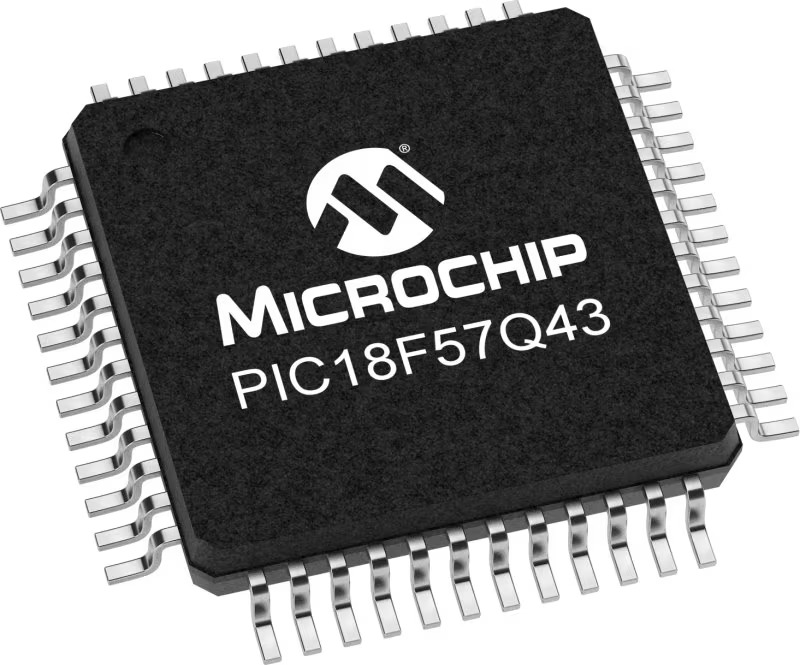我们的隔离创新简化了安全数据传输,提供了一个易于使用的桥梁,实现UART到RS232连接,同时提供安全可靠的通信通道。
A
A
硬件概览
它是如何工作的?
RS232 Isolator 2 Click基于Renesas的ICL3221,这是一款3.3V供电的RS232发射器/接收器,其RS232引脚提供±15kV ESD保护。它具有自动断电功能,当RS232电缆移除时自动节省系统电力,并在有效的RS232电压应用于任何接收器输入时重新上电。即使在最差的负载条件下,它也能确保数据速率超过250kbps。此Click板™采用PS9121,使用Renesas的光耦合高速低电平隔离器,包含输入端的GaAlAs LED、输出端的光电二极管和信号处理电路,额定隔离电压为3.75kV,数据速率高达15Mbps。
RS232收发器ICL3221的数据速率为250kbps,工作电压为3.0V至3.6V,外部电源通过板右侧的电源接头供电。除光耦器外,Toshiba Semiconductor的TC7SZ125FU逻辑缓冲器用于驱动所需的LED电流,这通常不能由低功耗MCU或RS232接收器输出提供。ICL3221通过UART接口与MCU通信,默认波特率为115200bps,用于数据传输。它还配备了标准的DB-9连接器,使得RS232接口变得简单易用。标记为INVALID的红色二极管指示器表明是否存在有效的RS232信号。当任何
接收器输入存在有效的RS232信号时,该二极管指示。当接口电缆从DB-9连接器断开并且所有接收器输入浮动时,ICL3221通过点亮LED检测无效电平。重新连接电缆会恢复接收器输入的有效电平,二极管熄灭,电源管理逻辑唤醒接口块。此Click板™只能在3.3V逻辑电压电平下操作。在使用具有不同逻辑电平的MCU之前,必须进行适当的逻辑电压电平转换。此外,它配备了包含函数和示例代码的库,可作为进一步开发的参考。
功能概述
开发板
PIC18F57Q43 Curiosity Nano 评估套件是一款尖端的硬件平台,旨在评估 PIC18-Q43 系列内的微控制器。其设计的核心是包含了功能强大的 PIC18F57Q43 微控制器(MCU),提供先进的功能和稳健的性能。这个评估套件的关键特点包括一个黄 色用户 LED 和一个响应灵敏的机械用户开关,提供无
缝的交互和测试。为一个 32.768kHz 水晶振荡器足迹提供支持,确保精准的定时能力。套件内置的调试器拥有一个绿色电源和状态 LED,使编程和调试变得直观高效。此外,增强其实用性的还有虚拟串行端口 (CDC)和一个调试 GPIO 通道(DGI GPIO),提供广泛的连接选项。该套件通过 USB 供电,拥有由
MIC5353 LDO 调节器提供支持的可调目标电压功能,确保在 1.8V 至 5.1V 的输出电压范围内稳定运行,最大输出电流为 500mA,受环境温度和电压限制。
微控制器概述
MCU卡片 / MCU

建筑
PIC
MCU 内存 (KB)
128
硅供应商
Microchip
引脚数
48
RAM (字节)
8196
你完善了我!
配件
Curiosity Nano Base for Click boards 是一款多功能硬件扩展平台,专为简化 Curiosity Nano 套件与扩展板之间的集成而设计,特别针对符合 mikroBUS™ 标准的 Click 板和 Xplained Pro 扩展板。这款创新的基板(屏蔽板)提供了无缝的连接和扩展可能性,简化了实验和开发过程。主要特点包括从 Curiosity Nano 套件提供 USB 电源兼容性,以及为增强灵活性而提供的另一种外部电源输入选项。板载锂离子/锂聚合物充电器和管理电路确保电池供电应用的平稳运行,简化了使用和管理。此外,基板内置了一个固定的 3.3V 电源供应单元,专用于目标和 mikroBUS™ 电源轨,以及一个固定的 5.0V 升压转换器,专供 mikroBUS™ 插座的 5V 电源轨,为各种连接设备提供稳定的电力供应。
使用的MCU引脚
mikroBUS™映射器
“仔细看看!”
Click board™ 原理图

一步一步来
项目组装
实时跟踪您的结果
应用程序输出
1. 应用程序输出 - 在调试模式下,“应用程序输出”窗口支持实时数据监控,直接提供执行结果的可视化。请按照提供的教程正确配置环境,以确保数据正确显示。

2. UART 终端 - 使用UART Terminal通过USB to UART converter监视数据传输,实现Click board™与开发系统之间的直接通信。请根据项目需求配置波特率和其他串行设置,以确保正常运行。有关分步设置说明,请参考提供的教程。

3. Plot 输出 - Plot功能提供了一种强大的方式来可视化实时传感器数据,使趋势分析、调试和多个数据点的对比变得更加直观。要正确设置,请按照提供的教程,其中包含使用Plot功能显示Click board™读数的分步示例。在代码中使用Plot功能时,请使用以下函数:plot(insert_graph_name, variable_name);。这是一个通用格式,用户需要将“insert_graph_name”替换为实际图表名称,并将“variable_name”替换为要显示的参数。

软件支持
库描述
该库包含 RS232 Isolator 2 Click 驱动程序的 API。
关键功能:
rs232isolator2_generic_write- RS232 Isolator 2 数据写入函数。rs232isolator2_generic_read- RS232 Isolator 2 数据读取函数。rs232isolator2_send_data- RS232 Isolator 2 数据发送函数。
开源
代码示例
完整的应用程序代码和一个现成的项目可以通过NECTO Studio包管理器直接安装到NECTO Studio。 应用程序代码也可以在MIKROE的GitHub账户中找到。
/*!
* @file main.c
* @brief RS232 Isolator 2 Click Example.
*
* # Description
* This library contains API for RS 232 Isolator 2 Click driver.
* This example transmits/receives and processes data from RS 232 Isolator 2 Clicks.
* The library initializes and defines the UART bus drivers
* to transmit or receive data.
*
* The demo application is composed of two sections :
*
* ## Application Init
* Initializes driver and wake-up module.
*
* ## Application Task
* Transmitter/Receiver task depend on uncommented code.
* Receiver logging each received byte to the UART for data logging,
* while transmitted send messages every 2 seconds.
*
* ## Additional Function
* - static void rs232isolator2_clear_app_buf ( void ) - Function clears memory of app_buf.
* - static err_t rs232isolator2_process ( void ) - The general process of collecting presponce
* that a module sends.
*
* @author Nenad Filipovic
*
*/
#include "board.h"
#include "log.h"
#include "rs232isolator2.h"
#define PROCESS_BUFFER_SIZE 200
#define TRANSMITTER
// #define RECIEVER
static rs232isolator2_t rs232isolator2;
static log_t logger;
static char app_buf[ PROCESS_BUFFER_SIZE ] = { 0 };
static int32_t app_buf_len = 0;
static int32_t app_buf_cnt = 0;
unsigned char demo_message[ 9 ] = { 'M', 'i', 'k', 'r', 'o', 'E', 13, 10, 0 };
/**
* @brief RS 232 Isolator 2 clearing application buffer.
* @details This function clears memory of application buffer and reset it's length and counter.
* @note None.
*/
static void rs232isolator2_clear_app_buf ( void );
/**
* @brief RS 232 Isolator 2 data reading function.
* @details This function reads data from device and concats data to application buffer.
*
* @return @li @c 0 - Read some data.
* @li @c -1 - Nothing is read.
* @li @c -2 - Application buffer overflow.
*
* See #err_t definition for detailed explanation.
* @note None.
*/
static err_t rs232isolator2_process ( void );
void application_init ( void ) {
log_cfg_t log_cfg; /**< Logger config object. */
rs232isolator2_cfg_t rs232isolator2_cfg; /**< Click config object. */
/**
* Logger initialization.
* Default baud rate: 115200
* Default log level: LOG_LEVEL_DEBUG
* @note If USB_UART_RX and USB_UART_TX
* are defined as HAL_PIN_NC, you will
* need to define them manually for log to work.
* See @b LOG_MAP_USB_UART macro definition for detailed explanation.
*/
LOG_MAP_USB_UART( log_cfg );
log_init( &logger, &log_cfg );
log_info( &logger, " Application Init " );
// Click initialization.
rs232isolator2_cfg_setup( &rs232isolator2_cfg );
RS232ISOLATOR2_MAP_MIKROBUS( rs232isolator2_cfg, MIKROBUS_1 );
err_t init_flag = rs232isolator2_init( &rs232isolator2, &rs232isolator2_cfg );
if ( init_flag == UART_ERROR ) {
log_error( &logger, " Application Init Error. " );
log_info( &logger, " Please, run program again... " );
for ( ; ; );
}
app_buf_len = 0;
app_buf_cnt = 0;
log_info( &logger, " Application Task " );
#ifdef TRANSMITTER
log_printf( &logger, " Send data: \r\n" );
log_printf( &logger, " mikroE \r\n" );
log_printf( &logger, "------------------\r\n" );
log_printf( &logger, " Transmit data \r\n" );
Delay_ms ( 1000 );
#endif
#ifdef RECIEVER
log_printf( &logger, " Receive data \r\n" );
Delay_ms ( 1000 );
Delay_ms ( 1000 );
#endif
log_printf( &logger, "------------------\r\n" );
}
void application_task ( void ) {
#ifdef TRANSMITTER
rs232isolator2_send_data( &rs232isolator2, demo_message );
log_printf( &logger, "%s", demo_message );
Delay_ms ( 1000 );
Delay_ms ( 1000 );
log_printf( &logger, "------------------\r\n" );
#endif
#ifdef RECIEVER
rs232isolator2_process( );
if ( app_buf_len > 0 ) {
log_printf( &logger, "%s", app_buf );
rs232isolator2_clear_app_buf( );
}
#endif
}
int main ( void )
{
/* Do not remove this line or clock might not be set correctly. */
#ifdef PREINIT_SUPPORTED
preinit();
#endif
application_init( );
for ( ; ; )
{
application_task( );
}
return 0;
}
static void rs232isolator2_clear_app_buf ( void ) {
memset( app_buf, 0, app_buf_len );
app_buf_len = 0;
app_buf_cnt = 0;
}
static err_t rs232isolator2_process ( void ) {
int32_t rx_size;
char rx_buff[ PROCESS_BUFFER_SIZE ] = { 0 };
rx_size = rs232isolator2_generic_read( &rs232isolator2, rx_buff, PROCESS_BUFFER_SIZE );
if ( rx_size > 0 ) {
int32_t buf_cnt = 0;
if ( app_buf_len + rx_size >= PROCESS_BUFFER_SIZE ) {
rs232isolator2_clear_app_buf( );
return RS232ISOLATOR2_ERROR;
} else {
buf_cnt = app_buf_len;
app_buf_len += rx_size;
}
for ( int32_t rx_cnt = 0; rx_cnt < rx_size; rx_cnt++ ) {
if ( rx_buff[ rx_cnt ] != 0 ) {
app_buf[ ( buf_cnt + rx_cnt ) ] = rx_buff[ rx_cnt ];
} else {
app_buf_len--;
}
}
return RS232ISOLATOR2_OK;
}
return RS232ISOLATOR2_ERROR;
}
// ------------------------------------------------------------------------ END
额外支持
资源
类别:RS232



































